Prediction of Scour Depth for Diverse Pier Shapes Utilizing Two-Dimensional Hydraulic Engineering Center’s River Analysis System Sediment Model
Abstract
1. Introduction
2. Two-Dimensional Model of HEC-RAS
3. Input Data
4. Hydraulic Model’s Performance
4.1. Setup Hydraulic Model
4.2. Sediment Transport Modeling
5. Model Calibration and Validation
5.1. Grid Size
5.2. Manning Coefficient
5.3. Time Step
6. Results and Discussion
6.1. The Model’s Performance
6.2. Bed Level Change
6.3. Effect of Floating Debris
7. Conclusions
Author Contributions
Funding
Data Availability Statement
Conflicts of Interest
References
- Tu, X.L.; Gambaruto, A.M.; Newell, R.; Pregnolato, M. Computational fluid dynamics analysis of bridge scour with a comparison of pier shapes and a debris fin. Structures 2024, 67, 106966. [Google Scholar] [CrossRef]
- Hamidifar, H.; Shahabi-Haghighi, S.M.B.; Chiew, Y.M. Collar performance in bridge pier scour with debris accumulation. Int. J. Sediment Res. 2022, 37, 328–334. [Google Scholar] [CrossRef]
- Palermo, M.; Pagliara, S.; Roy, D. Effect of debris accumulation on scour evolution at bridge pier in bank proximity. J. Hydrol. Hydromechanics 2021, 69, 108–118. [Google Scholar] [CrossRef]
- Hamidifar, H.; Mohammad Ali Nezhadian, D.; Carnacina, I. Experimental study of debris-induced scour around a slotted bridge pier. Acta Geophys. 2022, 70, 2325–2339. [Google Scholar] [CrossRef]
- Maddison, B. Scour failure of bridges. Proc. Inst. Civ. Eng. Eng. 2012, 165, 39–52. [Google Scholar] [CrossRef]
- Do Carmo, J.S.A. The Hintze Ribeiro bridge collapse and the lessons learned. In River Basin Management-Sustainability Issues and Planning Strategies; IntechOpen: London, UK, 2021. [Google Scholar]
- Wardhana, K.; Hadipriono, F.C. Analysis of recent bridge failures in the United States. J. Perform. Constr. Facil. 2003, 17, 144–150. [Google Scholar] [CrossRef]
- Landers, M.N. Bridge scour data management. USGS Staff. Res. 1992, 141, 1094–1099. [Google Scholar]
- Padgett, J.; DesRoches, R.; Nielson, B.; Yashinsky, M.; Kwon, O.-S.; Burdette, N.; Tavera, E. Bridge damage and repair costs from Hurricane Katrina. J. Bridg. Eng. 2008, 13, 6–14. [Google Scholar] [CrossRef]
- Nemry, F.; Demirel, H. Impacts of Climate Change on Transport: A focus on road and rail transport infrastructures. In JRC Scientific and Policy Reports; Publications Office of the European Union: Luxembourg, 2012. [Google Scholar]
- Brunner, G.W. HEC-RAS River Analysis System: Hydraulic Reference Manual, Version 5.0; US Army Corps of Engineers: Washington, DC, USA, 2016; Volume 547.
- Gary, W. Brunner HEC-RAS, River Analysis System Hydraulic Reference Manual. 2020. Available online: https://www.hec.usace.army.mil/software/hec-ras/documentation/HEC-RAS Hydraulic Reference Manual-v6.4.1.pdf (accessed on 25 September 2024).
- Nizam, N.B.; Das, R.R.; Mahalder, B. Experimental observation and comparison of sediment dynamics behavior in artificial channel using hec-ras 2D. In Proceedings of the the 5th Annual Paper Meet & 2nd Civil Engineering Congress, Dhaka, Bangladesh, 29–30 July 2022; pp. 445–450. [Google Scholar]
- Thembiliyagoda, A.; De Silva, K.; Wijayaratna, N. Application of HEC-RAS 2D Model to Simulate Scour Depth Around Bridge Piers-A Case Study on Kelanisiri Bridge, Sri Lanka. In Proceedings of the 2023 Moratuwa Engineering Research Conference (MERCon), Moratuwa, Sri Lanka, 9–11 November 2023; pp. 660–665. [Google Scholar] [CrossRef]
- Brunner, G.; Savant, G.; Heath, R.E. Modeler Application Guidance for Steady versus Unsteady, and 1D versus 2D versus 3D Hydraulic Modeling; USA. 2020. Available online: https://www.hec.usace.army.mil/publications/TrainingDocuments/TD-41.pdf (accessed on 25 September 2024).
- Melville, B.W.; Coleman, S.E. Bridge Scour; Water Resources Publication: Littleton, CO, USA, 2000. [Google Scholar]
- Talib, A.; Obeid, Z.H.; Hameed, H.K. New imperial equation for local scour around various bridge piers shapes. Int. J. Sci. Res. 2016, 5, 654–658. [Google Scholar]
- Baranwal, A.; Das, B.S.; Setia, B. A comparative study of scour around various shaped bridge pier. Eng. Res. Express 2023, 5, 015052. [Google Scholar] [CrossRef]
- Fael, C.; Lança, R.; Cardoso, A. Pier shape and alignment effects on local scour. In Proceedings of the SHF Conference: Small Scale Morphological Evolution of Costal, Estuarine and River Systems, Nantes, France, 6–7 October 2014; pp. 1–4. [Google Scholar]
- Diehl, T.H. Potential Drift Accumulation at Bridges; US Department of Transportation, Federal Highway Administration: Washington, DC, USA, 1997.
- Lagasse, P.F. Effects of Debris on Bridge Pier Scour; Transportation Research Board: Washington, DC, USA, 2010; Volume 653. [Google Scholar]
- Melville, B.W.; Dongol, D.M. Bridge pier scour with debris accumulation. J. Hydraul. Eng. 1992, 118, 1306–1310. [Google Scholar] [CrossRef]
- Bradley, J.B.; Richards, D.L.; Bahner, C.D. Debris Control Structures: Evaluation and Countermeasures; US Department of Transportation, Federal Highway Administration: Washington, DC, USA, 2005.
- Dongol, D.M.S. Effect of Debris Rafting on Local Scour at Bridge Piers; University of Auckland: Auckland, New Zealand, 1989. [Google Scholar]
- Cantero-Chinchilla, F.N.; Gustavo, A.M. Assessing the Effects of Debris Accumulations at River Bridges; University of Southampton: Southampton, UK, 2018. [Google Scholar]
- Al-Jubouri, M.; Ray, R.P.; Al-Khafaji, M.S. Unraveling Debris-Enhanced Local Scour Patterns around Non-Cylindrical Bridge Piers: Experimental Insights and Innovative Modeling. Sustainability 2023, 15, 15910. [Google Scholar] [CrossRef]
- Richardson, E.V.; Davies, S.R. Evaluating Scour at Bridges [Fourth Edition]; US Department of Transportation, Federal Highway Administration: Washington, DC, USA, 2001; p. 378. Available online: https://rosap.ntl.bts.gov/view/dot/50281 (accessed on 25 September 2024).
- Melville, B.W.; Sutherland, A.J. Design method for local scour at bridge piers. J. Hydraul. Eng. 1988, 114, 1210–1226. [Google Scholar] [CrossRef]
- Sanchez, A. HEC-RAS 2D Sediment User Manual; California. 2021. Available online: https://www.hec.usace.army.mil/confluence/rasdocs/h2sd/ras2dsed/latest (accessed on 25 September 2024).
- USACE; HEC-RAS. HEC-RAS 2D Sediment Technical Reference Manual. 2016. Available online: https://www.hec.usace.army.mil/confluence/rasdocs/d2sd/ras2dsedtr/6.2/model-description/water-and-sediment-properties/sediment-properties (accessed on 25 September 2024).
- Wu, W.; Wang, S.S.Y.; Jia, Y. Nonuniform sediment transport in alluvial rivers. J. Hydraul. Res. 2000, 38, 427–434. [Google Scholar] [CrossRef]
- Van Rijn, L.C. Sediment transport, part I: Bed load transport. J. Hydraul. Eng. 1984, 110, 1431–1456. [Google Scholar] [CrossRef]
- Van Rijn, L.C. Unified view of sediment transport by currents and waves. I: Initiation of motion, bed roughness, and bed-load transport. J. Hydraul. Eng. 2007, 133, 649–667. [Google Scholar] [CrossRef]
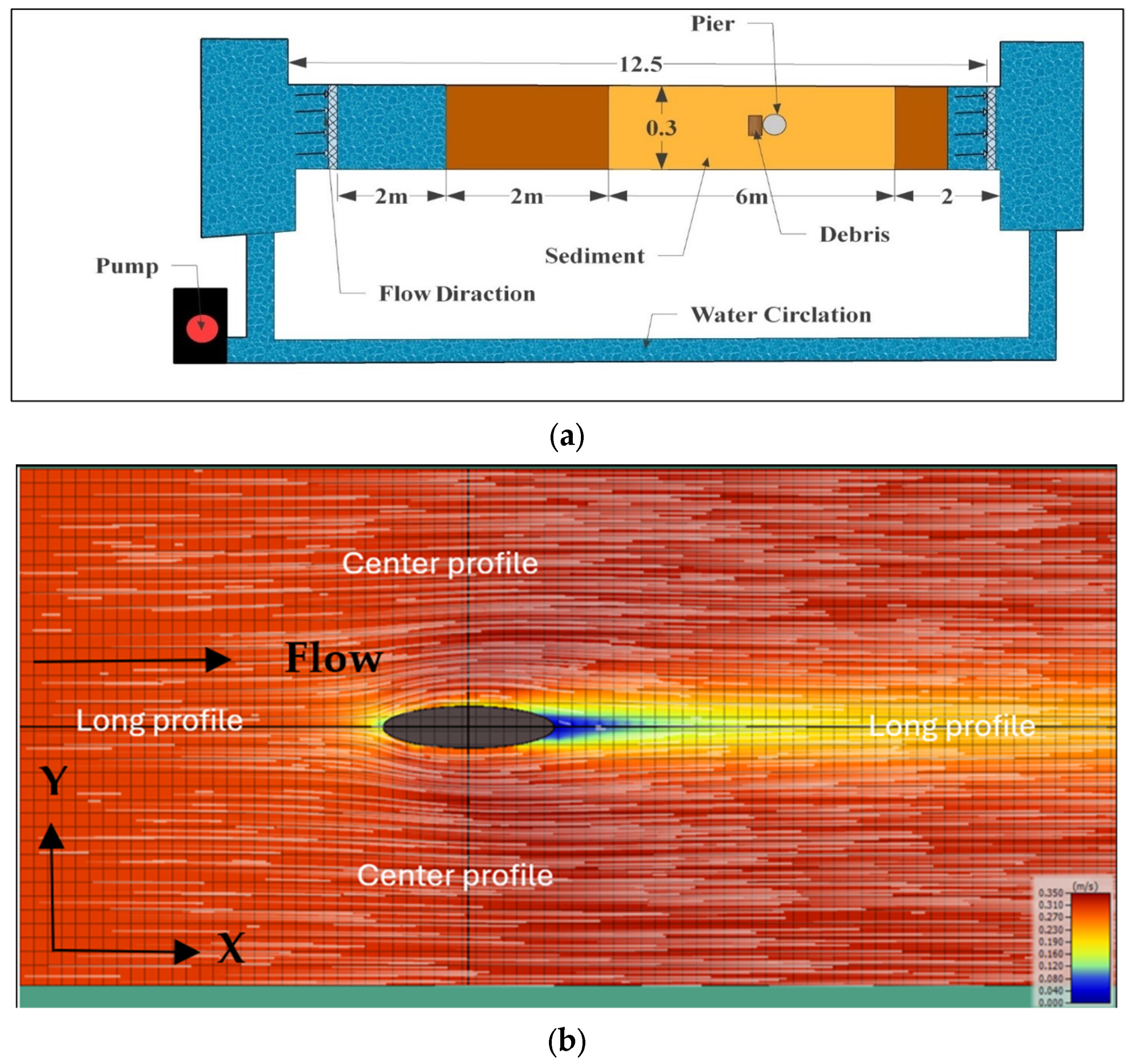
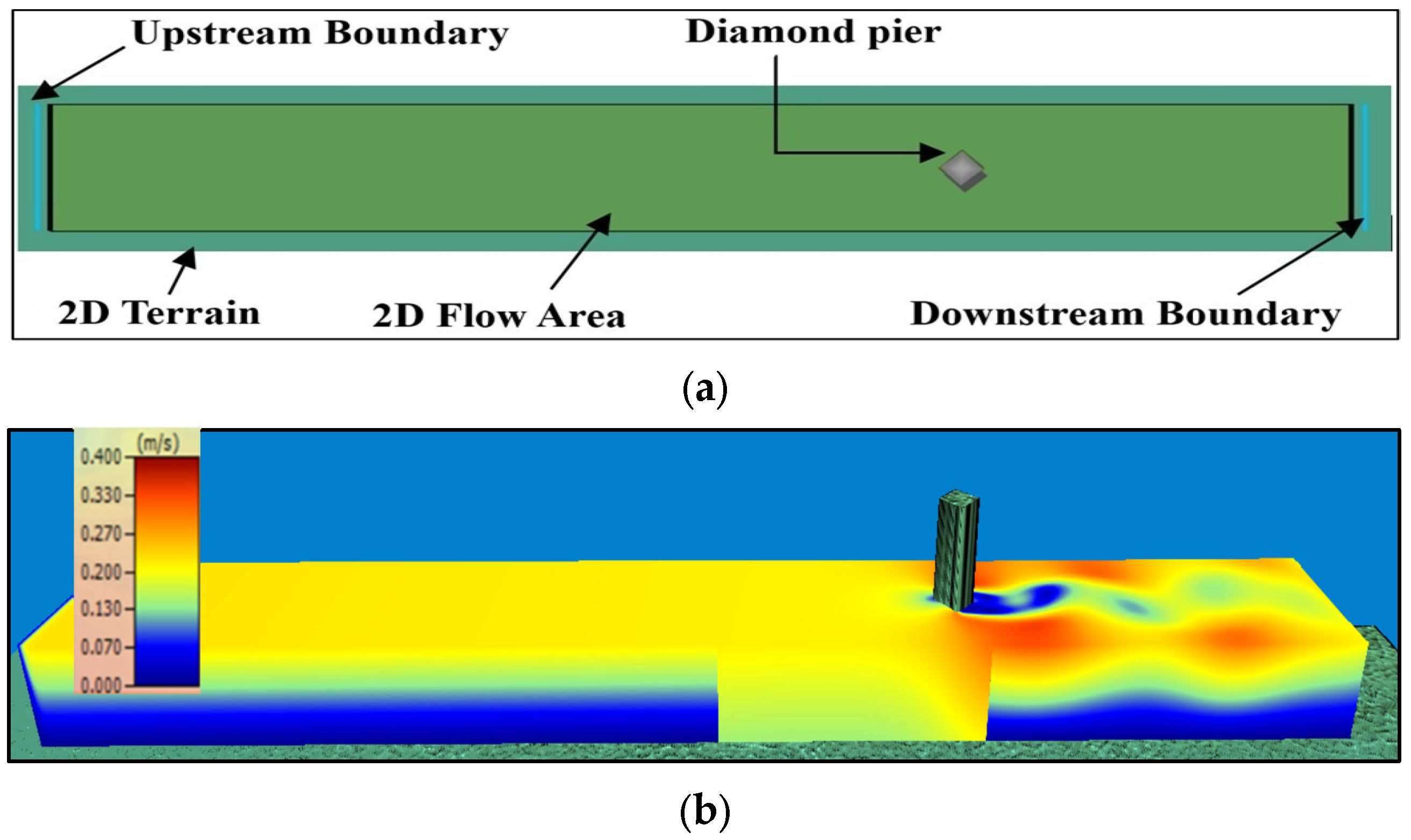
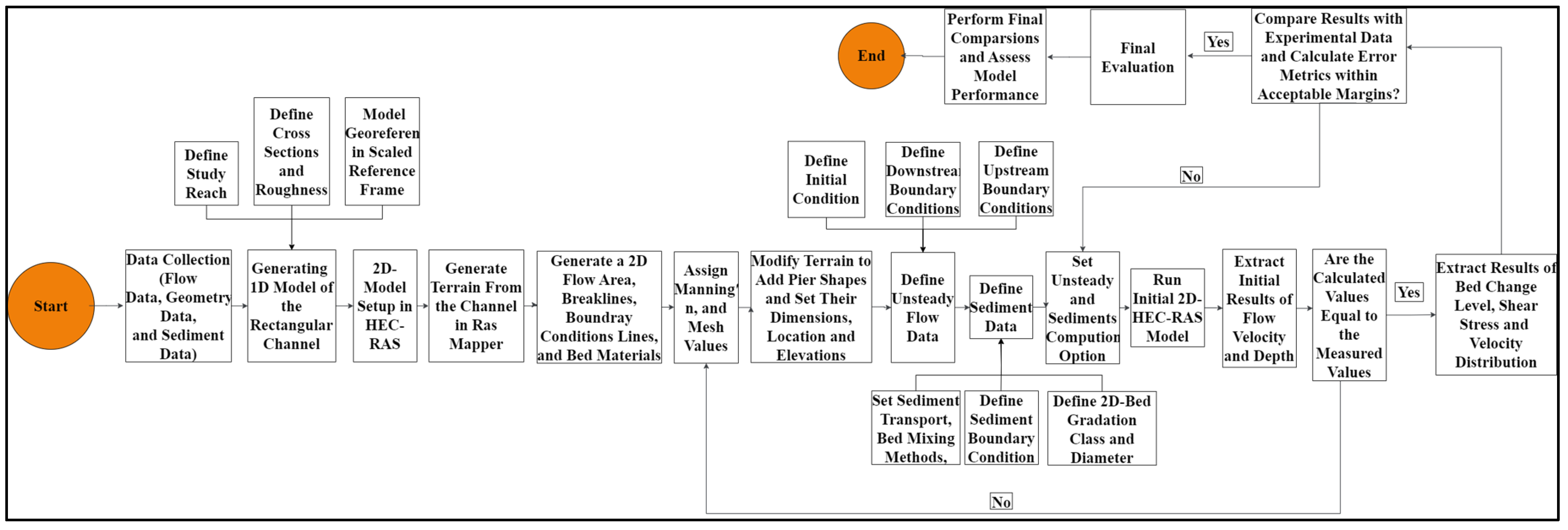
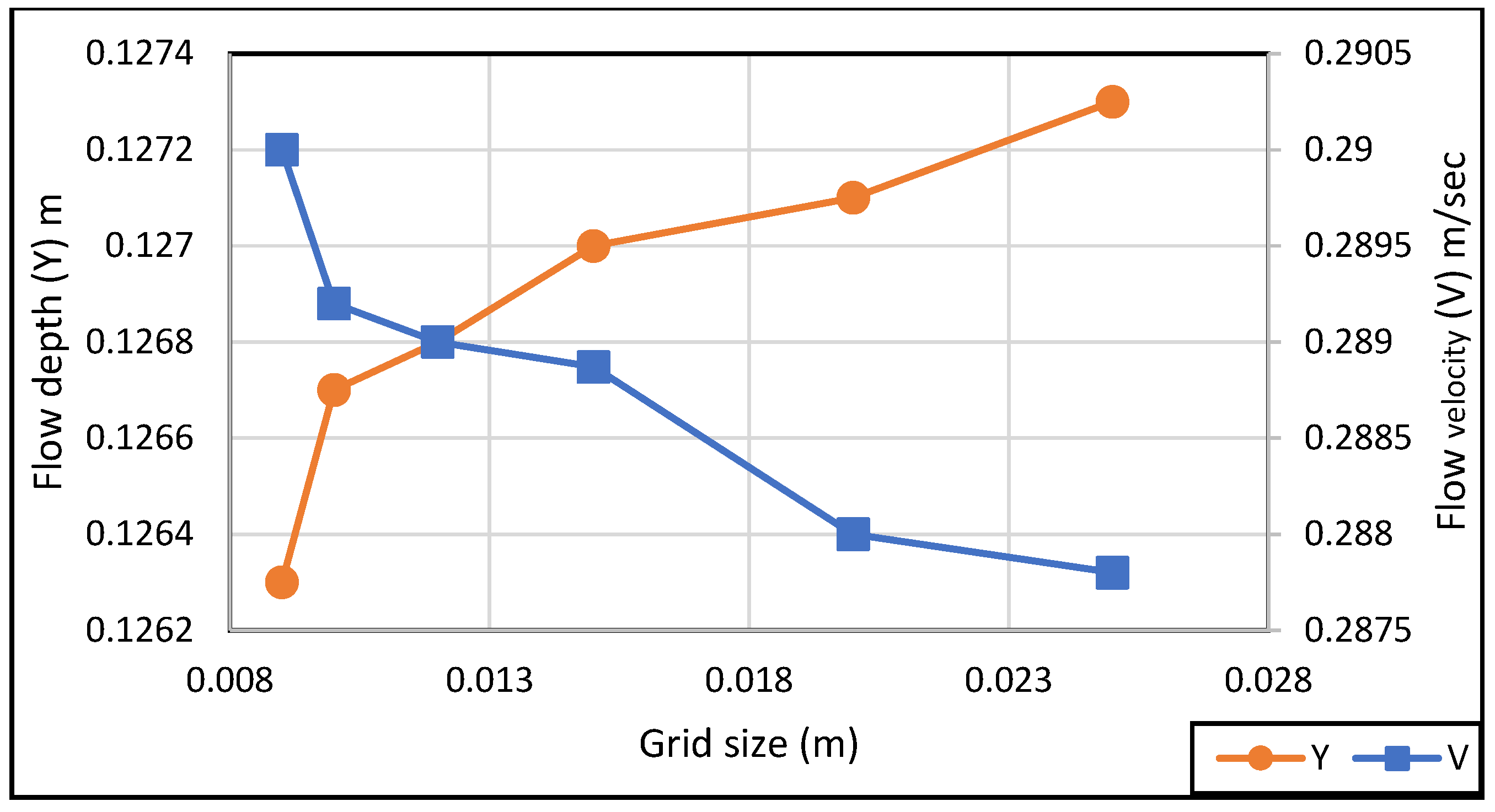
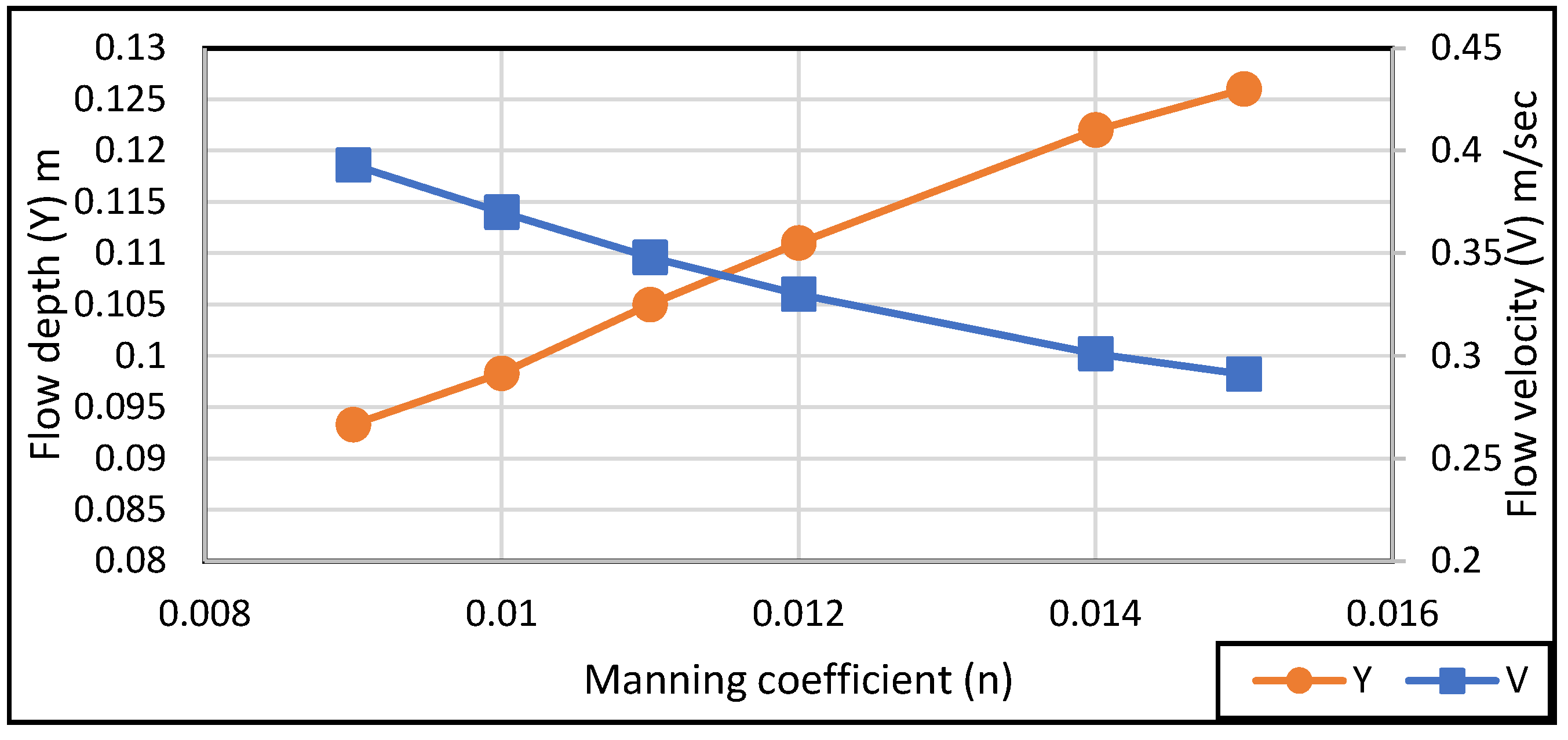


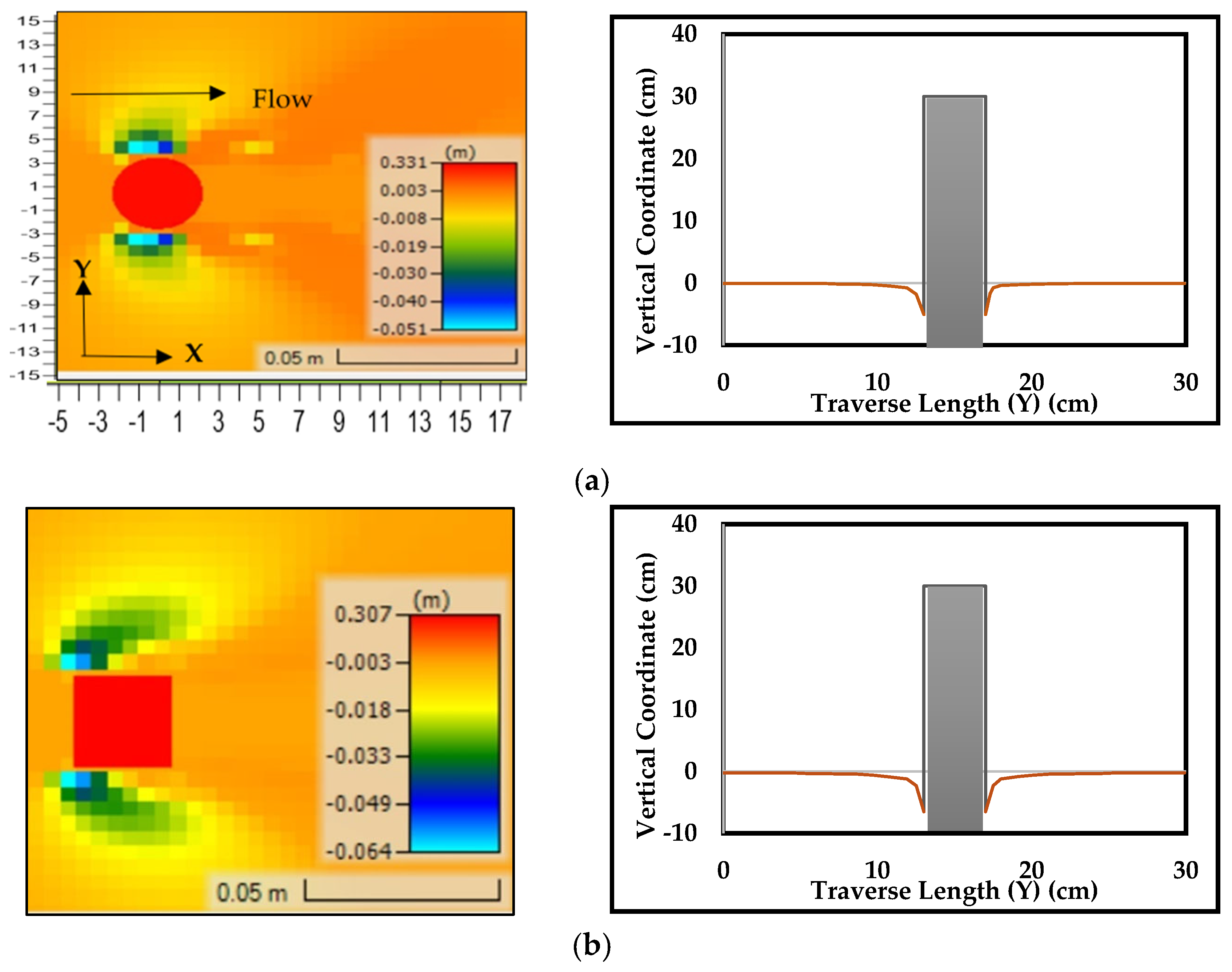
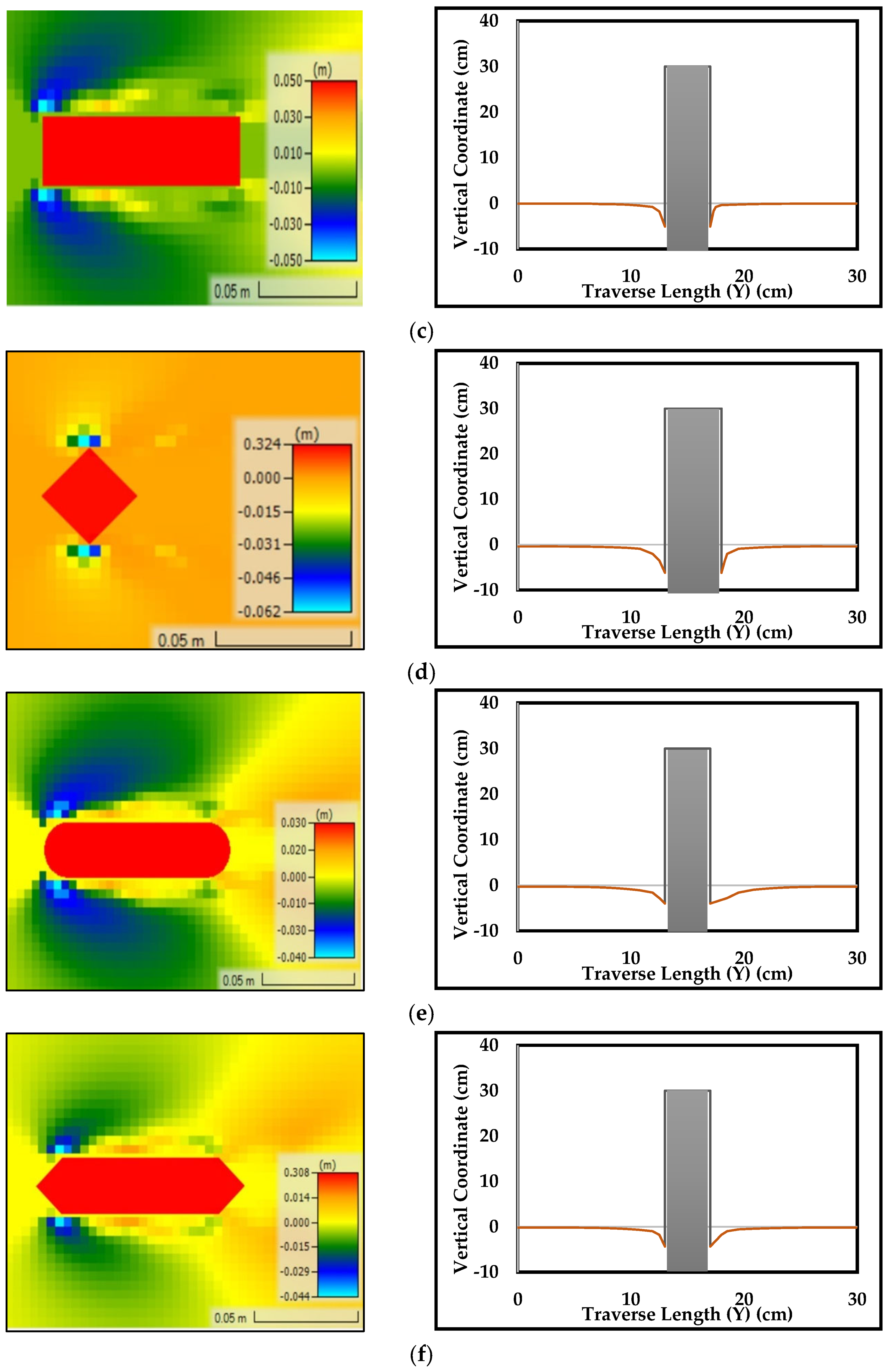

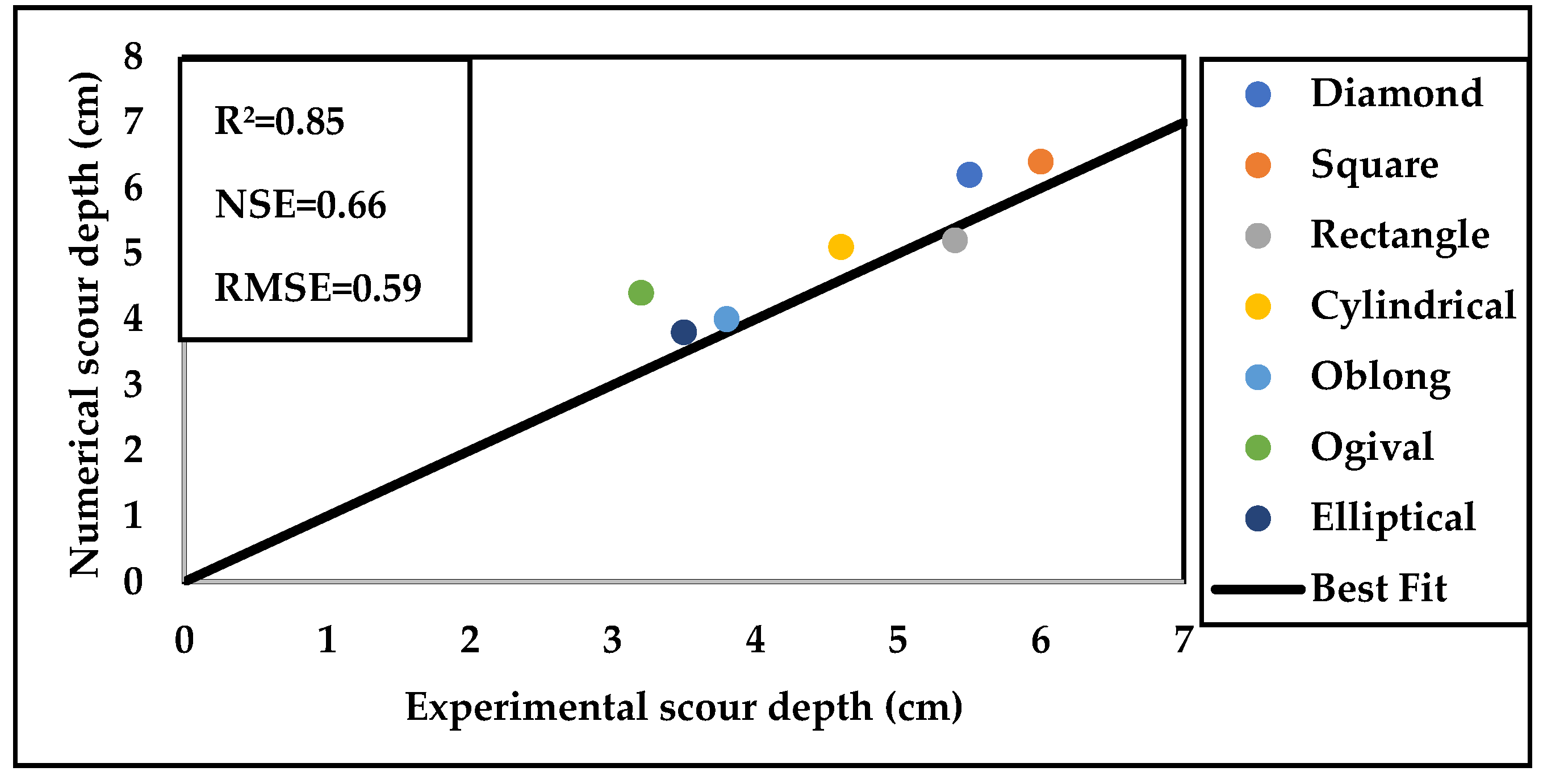
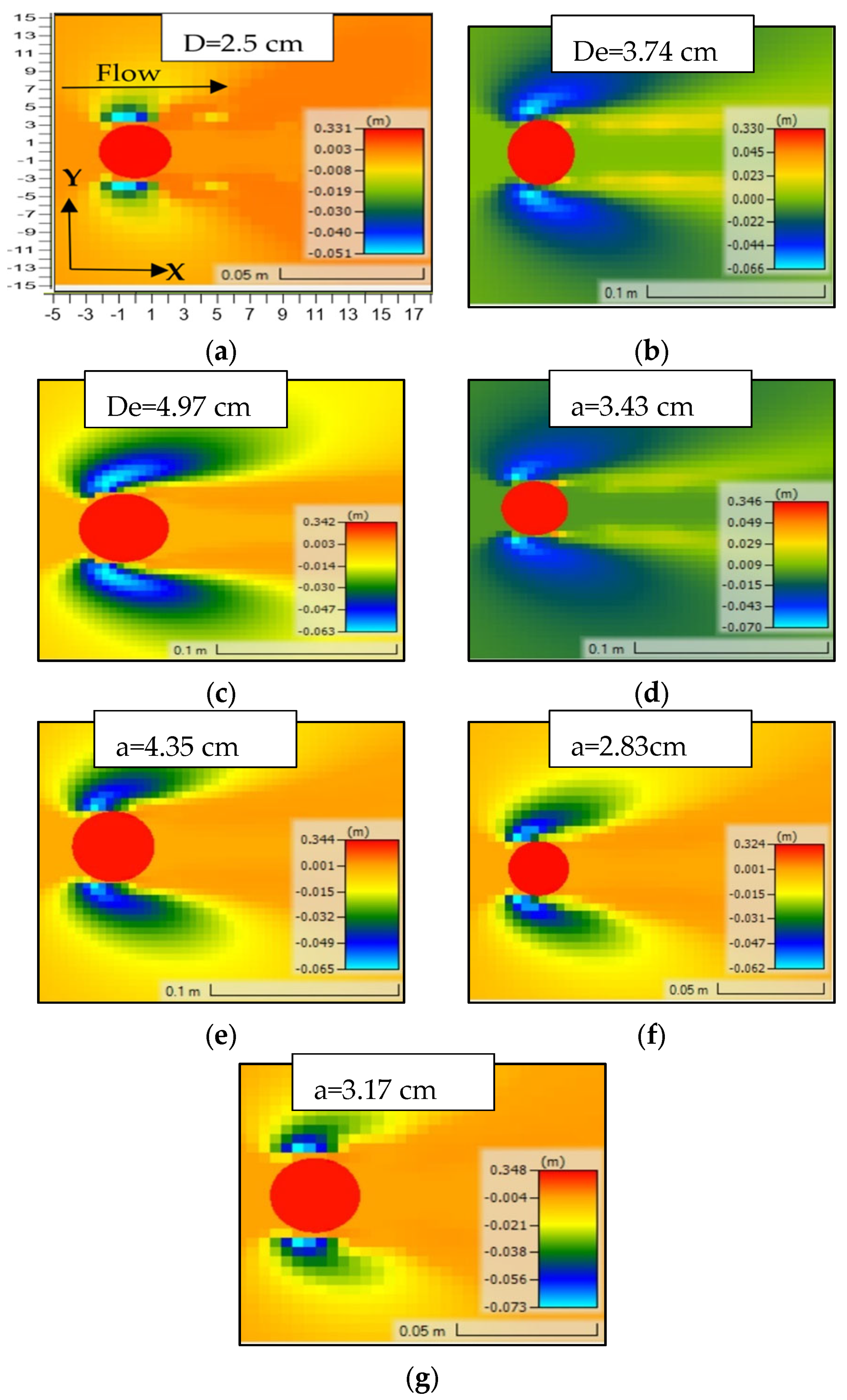
| Parameter | Description |
|---|---|
| Shallow Water Flow Equations | Uses the full shallow water flow equations for accurate 2D sediment transport modeling. |
| Hydraulic Warmup | Fills the 2D model with water before sediment transport to prevent instability and poor initial conditions. |
| Adaptation Length | Controls the speed of erosion and deposition; longer lengths slow changes, whereas shorter lengths accelerate them. |
| Sediment Matrix Solver | Numerical method for solving sediment transport equations; Paradiso is accurate but slower, and FGMRESSOR is faster. |
| Sediment Computation Multiplier | Adjust the balance between water and sediment travel times; higher values reduce runtime but may affect stability. |
| Morphological Acceleration | Scales bed changes to shorten simulation time; recommended factors below 25 for balance between speed and accuracy. |
| Debris Configuration | Experimental (cm) | HEC-RAS (cm) | Melville (1988) [28] (cm) | CSU (2001) [27] (cm) | % Error HEC-RAS | % Error Melville (1988) [28] | % Error CSU (2001) [27] | Performance Relative to Experimental Values |
|---|---|---|---|---|---|---|---|---|
| No Debris D = 2.5 cm | 4.6 | 5.1 | 6 | 4.84 | 10.87% | 30.43% | 5.22% | HEC-RAS: Underestimates; CSU (2001) [27] is closer to the experimental value. |
| Rectangle Debris-T/Y = 0.25-De = 3.74 cm | 7.1 | 6.6 | 8.964 | 6.28 | 7.04% | 26.25% | 11.55% | HEC-RAS: Closest to experimental value; best performance among all methods. |
| Rectangle Debris-T/Y = 0.5-De = 4.97 cm | 9.7 | 6.3 | 11.648 | 7.56 | 35.05% | 20.08% | 22.06% | HEC-RAS: Largest error compared to experimental values; all methods show high error. |
| Triangle Debris-T/Y = 0.25-De = 3.74 cm | 6 | 6.6 | 8.964 | 6.28 | 10.00% | 49.40% | 4.67% | HEC-RAS: Slight overestimation; CSU (2001) [27] has the lowest error. |
| Triangle Debris-T/Y = 0.5-De = 4.97 cm | 8.8 | 6.3 | 11.648 | 7.56 | 28.41% | 32.36% | 14.09% | HEC-RAS: Underestimates; CSU (2001) [27] provides a closer approximation to experimental values. |
| Rectangle Debris-T/Y = 0.25-a = 3.43 cm | 7.1 | 7 | 8.223 | 5.94 | 1.41% | 15.82% | 16.34% | HEC-RAS: Closest to experimental value; best performance among all methods. |
| Rectangle Debris-T/Y = 0.5-a = 4.35 cm | 9.7 | 6.5 | 10.446 | 6.93 | 32.99% | 7.69% | 28.56% | HEC-RAS: Larger error than experimental values; Melville (1988) [28] performs better. |
| Triangle Debris-T/Y = 0.25-a = 2.83 cm | 6 | 6.2 | 6.798 | 5.24 | 3.33% | 13.30% | 12.67% | HEC-RAS: Slightly overestimates; close to experimental values; best among methods. |
| Triangle Debris-T/Y = 0.5-a = 3.17 cm | 8.8 | 7.3 | 7.596 | 5.64 | 17.05% | 13.68% | 35.91% | HEC-RAS: Underestimates; Melville (1988) [28] is closer to experimental values. |
Disclaimer/Publisher’s Note: The statements, opinions and data contained in all publications are solely those of the individual author(s) and contributor(s) and not of MDPI and/or the editor(s). MDPI and/or the editor(s) disclaim responsibility for any injury to people or property resulting from any ideas, methods, instructions or products referred to in the content. |
© 2024 by the authors. Licensee MDPI, Basel, Switzerland. This article is an open access article distributed under the terms and conditions of the Creative Commons Attribution (CC BY) license (https://creativecommons.org/licenses/by/4.0/).
Share and Cite
Al-Jubouri, M.; Ray, R.P.; Abbas, E.H. Prediction of Scour Depth for Diverse Pier Shapes Utilizing Two-Dimensional Hydraulic Engineering Center’s River Analysis System Sediment Model. Fluids 2024, 9, 247. https://doi.org/10.3390/fluids9110247
Al-Jubouri M, Ray RP, Abbas EH. Prediction of Scour Depth for Diverse Pier Shapes Utilizing Two-Dimensional Hydraulic Engineering Center’s River Analysis System Sediment Model. Fluids. 2024; 9(11):247. https://doi.org/10.3390/fluids9110247
Chicago/Turabian StyleAl-Jubouri, Muhanad, Richard P. Ray, and Ethar H. Abbas. 2024. "Prediction of Scour Depth for Diverse Pier Shapes Utilizing Two-Dimensional Hydraulic Engineering Center’s River Analysis System Sediment Model" Fluids 9, no. 11: 247. https://doi.org/10.3390/fluids9110247
APA StyleAl-Jubouri, M., Ray, R. P., & Abbas, E. H. (2024). Prediction of Scour Depth for Diverse Pier Shapes Utilizing Two-Dimensional Hydraulic Engineering Center’s River Analysis System Sediment Model. Fluids, 9(11), 247. https://doi.org/10.3390/fluids9110247







